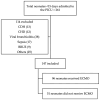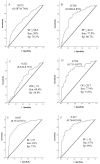Clinical Characteristics and Outcomes for Neonates with Respiratory Failure Referred for Extracorporeal Membrane Oxygenator (ECMO) Support
- PMID: 40723118
- PMCID: PMC12293768
- DOI: 10.3390/children12070925
Clinical Characteristics and Outcomes for Neonates with Respiratory Failure Referred for Extracorporeal Membrane Oxygenator (ECMO) Support
Abstract
Objective: The aim of this study was to describe the presenting characteristics and outcomes of neonates with respiratory failure referred for extracorporeal membrane oxygenation (ECMO) support, compare those who received ECMO support (ECMO group) to those who did not (non-ECMO group), and evaluate the predictive variables requiring ECMO support. Methods: All neonates (<15 days) with respiratory failure (without congenital diaphragmatic hernia or congenital heart disease) referred to our regional ECMO center from 2014 to 2023 were included in this retrospective study. Patient demographics, birth history, and clinical and outcome variables were analyzed. Oxygenation indices and vasoactive-inotropic scores obtained at PICU arrival and four hours after arrival were compared between the two groups using ROC analysis, with ECMO initiation as an outcome variable. Youden's index was used for optimal threshold values. Chi-square, Mann-Whitney U, and binary logistic regression were used for comparative analyses. Results: Out of the 147 neonates, 96 (65%) required ECMO support. The two groups significantly differed in the prevalence of pulmonary hypertension (pHTN; systemic or suprasystemic pulmonary pressures), lactate level, and oxygenation indices. Mortality was not different between the two groups. Presence of oxygen saturation index (OSI) ≥ 10 had a sensitivity 96.8% in predicting the need for ECMO support. On regression analysis, OSI and pHTN were independent predictors of ECMO support. Conclusions: Oxygenation indices and echo findings predict the need for ECMO support in neonatal hypoxemic respiratory failure. These findings help non-ECMO centers make appropriate and timely transfers of neonates with respiratory failure to ECMO centers.
Keywords: ECMO; neonatal respiratory failure; oxygenation index; persistent pulmonary hypertension of the newborn; vasoactive–inotropic score.
Conflict of interest statement
The authors declare no conflicts of interest.
Figures



Similar articles
-
Nitric oxide for respiratory failure in infants born at or near term.Cochrane Database Syst Rev. 2017 Jan 5;1(1):CD000399. doi: 10.1002/14651858.CD000399.pub3. Cochrane Database Syst Rev. 2017. PMID: 28056166 Free PMC article.
-
Extracorporeal membrane oxygenation for critically ill adults.Cochrane Database Syst Rev. 2015 Jan 22;1(1):CD010381. doi: 10.1002/14651858.CD010381.pub2. Cochrane Database Syst Rev. 2015. Update in: Cochrane Database Syst Rev. 2023 Sep 26;9:CD010381. doi: 10.1002/14651858.CD010381.pub3. PMID: 25608845 Free PMC article. Updated.
-
Extracorporeal membrane oxygenation for severe respiratory failure in newborn infants.Cochrane Database Syst Rev. 2002;(1):CD001340. doi: 10.1002/14651858.CD001340. Cochrane Database Syst Rev. 2002. Update in: Cochrane Database Syst Rev. 2008 Jul 16;(3):CD001340. doi: 10.1002/14651858.CD001340.pub2. PMID: 11869599 Updated.
-
Nitric oxide for respiratory failure in infants born at or near term.Cochrane Database Syst Rev. 2006 Oct 18;(4):CD000399. doi: 10.1002/14651858.CD000399.pub2. Cochrane Database Syst Rev. 2006. Update in: Cochrane Database Syst Rev. 2017 Jan 05;1:CD000399. doi: 10.1002/14651858.CD000399.pub3. PMID: 17054129 Updated.
-
Nitric oxide for respiratory failure in infants born at or near term.Cochrane Database Syst Rev. 2001;(2):CD000399. doi: 10.1002/14651858.CD000399. Cochrane Database Syst Rev. 2001. PMID: 11405963
References
LinkOut - more resources
Full Text Sources

